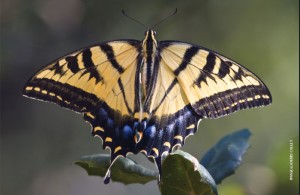
Photo copyright Denis Calet. Used with permission.
scw
Spiders, lizards and ladybugs…now butterflies will be added to the list of critters that Angelenos can be on the lookout for as they help scientists from the Natural History Museum discover what exactly is lurking and living in the urban backyards of Los Angeles County. Set to launch this April, this new community science program – The L.A. Butterfly Survey – follows on the footsteps of three other on-going field research projects that aim to discover exactly where the wild things are in the Southland.
Partnering with the Butterfly and Moths of North America (which has the greatest acronym ever, BAMONA), the NHM’s Lost Butterfly Project asks L.A. County residents to do simple backyard field work (data recording, photo snapping, emailing info) all in the name of science.
“The project will kick off in conjunction with the opening of our Butterfly Pavilion,” says Lila Higgins who coordinatesthe NHM’s community science programs. While keeping an eye out for flutterbys, folks are also encouraged to scan their gardens, bushes, trees and greenery for ladybugs which usually migrate from the mountains to the lowlands this time of year. “Aphids are more prominent which attracts hungry, hungry ladybugs,” says Higgins.
While these community projects make it easy for Angelenos to become scientists for an afternoon they are a nice reminder about the diversity of life that can be found in a normal L.A. backyard, says Higgins.
Another reason to participate? Maybe you’ll get a shot at some minor fame like the Bernstein family of Chatsworth experienced last year when they discovered a new population of the Mediterranean House Gecko (Hemidactylusturcicus), the first ever recorded case of these lizards in Los Angeles County.
Still, maybe it’s the thrill of the hunt that can motivate L.A. residents to join the cause, especially if what you’re chasing has eight legs, numerous eyes and sharp fangs for sucking out life juices.
Launched in 2002, the NHM’s Spider Survey has yielded more than 6,000 actual spider specimens to its collection of L.A. County arachnids. Yup, the museum actually wants your dead spiders. “It’s been a great program and we still have folks sending in specimens,” gushes Higgins. “We have plenty of the common spiders we find around Southern California, like the orb weaver, etc., but what we really need are specimens of ground-dwelling spiders such as wolf spiders, the ones that aren’t so easy to find.”
Six thousand spider specimens? “It’s not as big as you’d think,” says Higgins. “They all fit nicely in one room at the museum.” We can only imagine the names the NHM folks could have for that room: Spider Salon, Creepy Corner, Arachnid Nook, well, the list could go on…
To find out submission guidelines for the Natural History Museum’s Community Programs, go to: http://www.nhm.org/site/activities-programs/community-science/.
— Brenda Rees, editor
